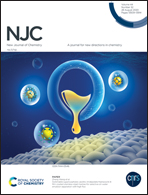High rejection performance ultrafiltration membrane with ultrathin dense layer fabricated by the movement and dissolution of metal–organic frameworks†
Abstract
Ultrafiltration membranes have potential to solve the problems of water pollution and shortage. In order to obtain good solute selectivity, a dense layer is often introduced on the surface of the membrane. However, this approach fails to achieve maximum permeability and solute selectivity with minimum transport resistance. In this study, a metal–organic framework was prepared and blended with polyethersulfone as a modification additive to construct an ultra-thin dense layer structure that functions as a metal–organic framework modified polyethersulfone membrane. The thickness of the metal–organic framework modified polyethersulfone membrane dense layer decreased with the increase in the metal–organic framework content, and the thickness was reduced to 123 nm. Therefore, the resistance of the water transport on the dense layer was reduced, which increased the permeability of the polyethersulfone membrane. When the metal–organic framework content was 4 wt%, the water flux of the metal–organic framework-modified polyethersulfone membrane was 55.696 L m−2 h−1, and the high rejection ratio of bovine serum albumin and congo red were 98 and 97%, respectively. Thus, adjusting the thickness of the dense layer can improve the permeability of a metal–organic framework-modified polyethersulfone membrane and retain the solute selectivity, which gives the membrane the potential to be used for water treatment.



 Please wait while we load your content...
Please wait while we load your content...